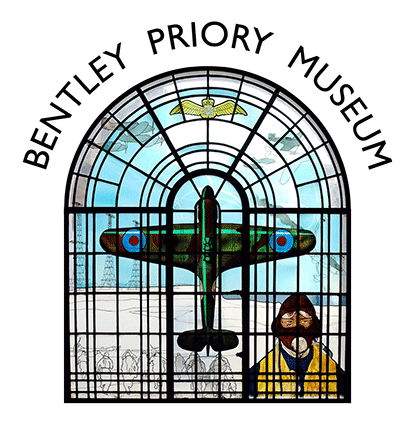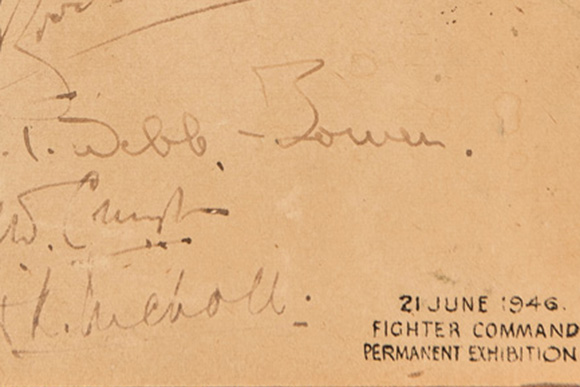1946
Dimensions: 21cm x 16cm
Materials: Wood and Paper
To listen to the audio description of this object either click the object audio MP3 file below which will play it in your default audio player, or press the play button which you will find after the object audio MP3 file and this will play it from within the web page. The play button can also be used to pause the audio. This button is followed by the elapsed and remaining time, and a further button to mute the audio.
Exhibition Plaque Audio MP3 File
This small wooden plaque, showing signatures of leading RAF officials, stands about 20 centimetres high and 15 centimetres wide. It has a flat, slightly angled front and a supporting piece of wood perpendicular at the back to allow it to stand. The wood is quite scuffed and worn and is a deep brown. Stuck to the front of the plaque is some slightly yellowed paper. This is smaller than the plaque itself and so the wood forms a frame, a couple of centimetres wide, around the edge of the paper. In the bottom right hand corner of the paper, handwritten in capitals is ‘21 June 1946 Fighter Command Permanent Exhibition’.
The paper has been signed by 12 individuals. All signatures are in black ink but some have faded over time and appear quite faint. Each signature is slightly crooked suggesting that the paper was signed in an informal way. Ten signatures are on the left hand side and where space ran out, two have signed on the right. Signatures include Sir Philip Joubert de la Ferte (Director of Public Relations), Sir Roderic Hill (Principal Air Aide-de-Camp to the King), Sir James Robb (Air Officer Commander in Chief, Headquarters Fighter Command) and Arthur Tedder (Chief of the Air Staff).
Following the Second World War, RAF staff realised the vital role which RAF Bentley Priory had played in the success of the Battle of Britain in 1940. The Dowding System, the innovative air defence network, which had been overseen by Air Chief Marshal Sir Hugh Dowding at RAF Bentley Priory, was crucial to the outcome of the Battle. Keen to pay tribute and ensure that the achievements of all those who had worked so hard was understood, the Fighter Command Permanent Exhibition was created. It was hoped that distinguished visitors would come, and the information would also be used to help train and educate RAF personnel.
The plaque was signed to show the support of high ranking officials. The visitor book for Fighter Command also bears their signatures on this day, which is listed as the opening.
The exhibition was set up in the underground bunker at RAF Bentley Priory, and the Operations Room and War Room were set up as they would have been during active operations. There were displays detailing the role of radar, the different types of aircraft and pictorial maps of key days in the Battle.
In later years the exhibition was downsized and moved into Dowding’s office, setting a precedent for the museum today.
 What’s On
What’s On Opening Hours & Admission
Opening Hours & Admission

